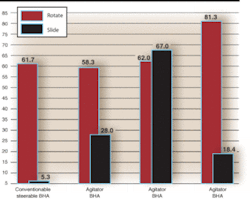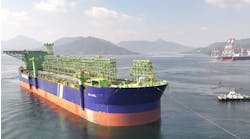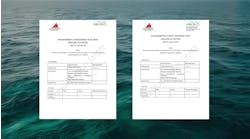Shell Nigeria sidetrack in Bonga field hits target precisely
Olusola Falodun
Halliburton Energy
Services Nigeria Ltd.
Kingsley Erhunmwunsee
Shell Nigeria
Exploration & Production Co.
Mike Kellas
Andergauge Drilling Systems
During the drilling of the Bonga 10ST 3(sidetrack No. 3) horizontal well in deepwater offshore Nigeria, Shell Nigeria Exploration Co. (Snepco) introduced an at-bit-inclination sensor and agitator tools that allowed the driller to optimally place the Bonga 10ST 3 drain hole in the reservoir. The application of these horizontal drilling technologies was a first for Shell Nigeria.
The most critical real-time data required for drilling directional wells is the angle of inclination. The advantages of measuring inclination within a few feet of the bit are enormous, as it allows the driller to determine the directional behavior of the bottom hole assembly, reduce the number of sidetracks due to directional steering problems, and more precisely place a wellbore in a reservoir.
The Bonga field lies 120 km from the Nigerian coastline in water depths of 3,100 ft to 3,600 ft. A number of challenging horizontal wells have been drilled since the inception of operations in late 2000, and one of them was the Bonga 10 horizontal sidetrack well drilled and completed in early 2004. The key drivers for Snepco, the operator, were completion reliability and sand control that could be achieved if the wellbore were less tortuous.
In the 1980s and early ‘90s, drillers had to contend with the lack of at-bit sensors. Hole problems such as well tortuosity, high doglegs, spiral hole, poor weight transfer to the bit, and poor rate of penetration were common experiences, especially in extended reach horizontal wells. In this case, the introduction of an at-bit inclination (ABI) sensor and the Andergauge Agitator helped to minimize all of these problems while providing a comparable cost-effective alternative to rotary steerable systems.
The ABI sensor was developed to specifically measure inclination at the bit, as opposed to the practice of measuring it about 60 ft from the bit. Measuring at the bit eliminates guesswork and keeps the bit within the pay zone. Drillers can react quickly to changes in the build or drop tendencies of the bottom hole assembly (BHA).
The agitator used in conjunction with a mud motor was selected because of its ability to aid weight transfer to the bit, provide excellent toolface control, and improve rate of penetration in rotary and oriented drilling modes.
Bonga 10 well
Snepco designed the Bonga 10 horizontal producer well to be drilled and completed as a high-rate producer in a major reservoir complex in the Bonga field. Snepco’s target is to complete a minimum of 1,000 ft of net sand along the hole, with the completed section passing from the reservoir top through the reservoir base.
The well was successfully drilled into the reservoir, placing the 12 1⁄4-in. hole at 82° inclination and setting the 9 5/8-in. casing just above the top of the reservoir. Two sidetracks were required. The first was the planned horizontal landing section and the second was a re-drill of the landing section after the drill string was stuck and abandoned in the first sidetrack hole.
Snepco’s ST2 8 1⁄2-in. horizontal drain hole had to be abandoned following the inability to recover the acid wash assembly, which was stuck in the completions sandscreen. Post analysis of the scenario highlighted several factors that could have contributed to the problem, e.g., junk in the wellbore, localized doglegs/hole, tortuosity, and parted completions screens.
From the 8 1⁄2-in. drilling focus, Snepco attributes the localized doglegs mostly to the late response by the directional driller in correcting hole inclinations due to the distance of the survey sensors from the bit. Poor weight transfer to the bit and poor rate of penetration were also experienced in the course of drilling the 8 1⁄2-in. hole section.
Hence, to address these drilling-related problems, it became necessary to explore the use of technology that would eliminate or at least minimize these drilling challenges. Shell opted for the use of the at-bit inclination sensor and the agitator tool.
Drilling challenges
A contributing factor that led to the previous sidetracks was the position of the directional and inclination sensor approximately 69 ft behind the bit. This design does not allow the directional driller to react quickly to changes in desired wellbore trajectory until the inclination and directional sensor crosses the point of “change.”
Following the abandonment of the ST2 8 1⁄2-in. drain hole, the Bonga 10 horizontal sidetrack No. 3 well had a 95-ft window between the 9 5/8-in. casing shoe and the top of the “fish” (comprising backed-off acid wash assembly and sandscreen). This situation called for the well to be sidetracked away from the “fish” within the 95-ft window and drilled along a planned trajectory while satisfying the following objectives:
• Dogleg less than 5°/100 ft
•“Smooth” hole to ensure that sand screens could be run to planned depth without damage
• Drill a gauged hole to aid efficient gravel pack
• Keep the well trajectory within 5 ft TVD (true vertical depth) tolerance.
Constraints
Snepco identified a number of constraints to achieving the objectives:
• Drilling a smooth trajectory and a good hole in addition to meeting the AFE (authorization for expenditure) budgeted time
• The 95-ft window between the 9 5/8-in. casing shoe and the top of the abandoned sand face completion gives very little room for maneuver. The kick-off needed to be achieved in a short depth interval but without excessive dogleg severity
• Drilling out the cement column from inside the 9 5/8-in. casing required careful consideration of BHA and bit choice, as the BHA used for cleaning out the cement column may not be suitable for drilling the remainder of the sidetrack
• Utmost consideration needed to be given to the provision of a high degree of certainty that the desired sidetrack off the cement plug will be achieved.
• Location of the agitator either above or below the LWD string. Placing it below the logging-while-drilling (LWD) string will jeopardize the objective of having the at-bit-inclination sensor transmitter close to the bit as possible
• Combined magnetic interference on measurement-while-drilling (MWD) tools from casing, fish, or other obstructions.
Solution
Prior to drilling the 8 1⁄2-in. horizontal hole, Snepco brought together all service providers to be involved in the project for a pre-job plan to deliberate on how to address the constraints. The major components of the BHA were the conventional steerable motor with a 1.50° bend, an 8 3/8-in. wear pad (in place of straight sleeve stabilizers), an 8 1/8-in. string stabilizer on the motor to provide moderate build tendency, an at-bit inclination sensor 3 ft from the bit, and an agitator made up above the MWD string.
The BHA was run in the hole to the top of the cement at 11,870 ft and drilled the cement out to the 9 5/8-in. casing shoe at 11,878 ft. The sidetrack was initiated just below the casing shoe by time-drilling in oriented mode using the high side/gravity toolface setting at the rate of 8.0 ft/hour.
After drilling 26 ft below the shoe, the rate of penetration was increased, once the entire mud motor length was in the open hole. Deviation (inclination) surveys were taken at intervals from the kick-off point and the sidetrack was confirmed successful through the inclination reading from the at-bit inclination sensor. The at-bit inclination sensor accuracy was confirmed at regular intervals with the direction and inclination sensor on the MWD string.
The BHA was pulled out of hole to change the bit and the bend angle on the mud motor as planned, after a total footage of 728 ft was drilled to a measured depth of 12,612 ft, with an inclination of 91.85° and azimuth of 183.66°.
The second BHA run had the bend angle on the mud motor changed from 1.50° to 1.15° to reduce the build and turn tendency using the same bit type. Drilling began again at the previous run total depth in the oriented mode to keep the well trajectory within the required 5-ft TVD tolerance window.
The at-bit inclination sensor and the agitator performance were monitored and the well was successfully drilled to total depth of 13,876 ft.
On target
The 8 1⁄2-in. horizontal hole section was drilled on target and within the 5-ft TVD tolerance as required by the operator. The hole was smooth, as evidenced by a smooth completion run to TD (total depth).
There was an appreciable improvement in drilling efficiency achieved by the use of the agitator, due to the total elimination of weight stacking and hang up. This improvement ensured smooth weight transfer to the bit, allowing better directional control with no motor stalling.
With the use of the agitator, the rate of penetration (ROP) was comparable with conventional rotary; however, in sliding mode, the ROP increased dramatically from 5.3ft/hr to 28ft/hr and 67ft/hr, respectively, in the two runs of ST-3.
Snepco landed the completions screens smoothly and effortlessly with less than 20K drag, as required, due to less tortuosity in the horizontal well bore compared to ST- 2.
The combination of the at-bit inclination sensor and the agitator significantly helped to address the constraints and challenges that drove the need for a third sidetrack.•





